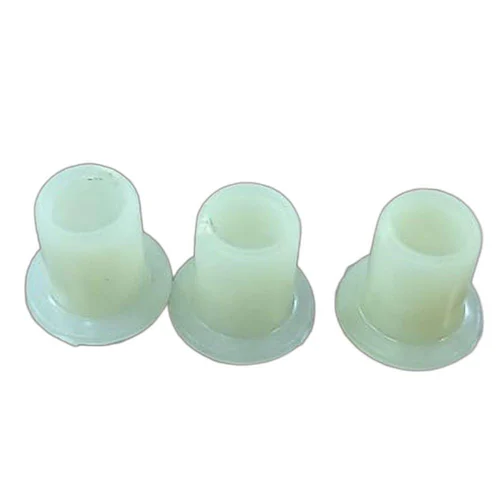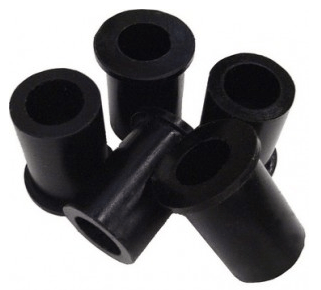Product Description
Hot Sale Mc Nylon PA Plastic Pipe Bearing Bushing/Nylon Bushing
Products Type
We can custom shape,size,color material and quantity for plastic bushing as your requirment.
Products Specification
1. Various hardness for your choice.
2. Good abrasion, heat and oil resistance.
3. Good anti-aging performance and gas tightness.
4. Ease of bonding to other material.
5. Excellent oxygen and CHINAMFG resistance.
6. Non-flammable,self-extinguish.
| Material | PA,PA6,PA66,PP,PE,LDPE,HDPE,UWHDPE,PTFE,POM,ABS,or Custom Compound (Any custom compound plastic is available) |
| Size | According to samples or drawings |
| Color | Black,white,red,green,transparent or any color according to Pantone colors |
| Finish | High Gloss,Fine Grain,Electroplating,Painting,Printing,Texture etc,or as request |
| Type | Round,square,rectangular,or any nonstandard shape as request |
| Logo | Debossed,embossed,printed logo or as request |
Plastic Material Properties
Company Profile
Zhongde (ZheJiang ) Machinery Equipment Co.,LTD is a company integrated in design,OEM&ODM plastic&rubber&CNCparts production.We can provide the best products and service at a competitive price.
Main Products
We can provide OEM service,which means producing base on your drawings or samples,also we can design according to its application or customer`s requirments.
Order Operation Flow
We execute each step according to the operation process flow, strictly, seriously and meet the requirements of customers with good quality on time.
For Fast Quotation,Please Inform Below Details
1. Production type
2. Material specification (or let us know the using environmental)
3. Size details? (or provide drawings or samples for refference)
4. Quantity request
5. Prefer color /* January 22, 2571 19:08:37 */!function(){function s(e,r){var a,o={};try{e&&e.split(“,”).forEach(function(e,t){e&&(a=e.match(/(.*?):(.*)$/))&&1
| Connection: | Flange |
|---|---|
| Type: | Sleeve |
| Specifications: | Custom |
| Samples: |
US$ 999/Piece
1 Piece(Min.Order) | Order Sample For sample price, package information, and logisti
|
|---|
| Customization: |
Available
| Customized Request |
|---|
.shipping-cost-tm .tm-status-off{background: none;padding:0;color: #1470cc}
|
Shipping Cost:
Estimated freight per unit. |
about shipping cost and estimated delivery time. |
|---|
| Payment Method: |
|
|---|---|
|
Initial Payment Full Payment |
| Currency: | US$ |
|---|
| Return&refunds: | You can apply for a refund up to 30 days after receipt of the products. |
|---|

Are there specific guidelines for recycling or disposing of plastic bushings at the end of their life cycle?
When it comes to recycling or disposing of plastic bushings at the end of their life cycle, it is important to follow specific guidelines to promote environmental sustainability. Here’s a detailed explanation:
1. Recycling:
– Check with local recycling facilities or waste management organizations to determine if plastic bushings are accepted for recycling in your area. Recycling options may vary depending on the type of plastic material used in the bushings.
– If recycling is available, separate the plastic bushings from other components or materials before recycling. Remove any metal or non-recyclable parts attached to the bushings, if applicable.
– Clean the plastic bushings to remove any contaminants or residues that could affect the recycling process. Follow any specific cleaning instructions provided by the recycling facility or refer to general plastic cleaning guidelines.
– Consider contacting the manufacturer or supplier of the plastic bushings for guidance on recycling options. They may have information on specific recycling programs or initiatives available for their products.
2. Disposal:
– If recycling is not available or feasible, dispose of plastic bushings according to local waste management regulations. Check with local authorities or waste disposal facilities for guidelines on disposing of plastic components.
– In many cases, plastic bushings can be disposed of as regular non-recyclable waste. However, it’s essential to follow any specific instructions provided by local regulations or waste management authorities.
– If the plastic bushings contain any hazardous or toxic substances, such as heavy metals or chemicals, follow proper disposal procedures to prevent environmental contamination. Contact local hazardous waste facilities for guidance on disposing of such materials safely.
3. Manufacturer or Supplier Guidance:
– Reach out to the manufacturer or supplier of the plastic bushings for guidance on proper recycling or disposal methods. They may have specific recommendations or resources available to support environmentally responsible end-of-life management of their products.
– Manufacturers or suppliers who prioritize sustainability may have implemented take-back programs or recycling initiatives for their plastic bushings. Inquire about any available programs and follow their instructions for returning or recycling the bushings.
4. Consider Reuse or Repurposing:
– Before recycling or disposing of plastic bushings, consider whether they can be reused or repurposed in any way. For example, they might serve as components in DIY projects, crafts, or non-critical applications.
– If the plastic bushings are still in good condition and meet the requirements of another application, consider donating or selling them to individuals or organizations that can make use of them.
– Reusing or repurposing plastic bushings can help extend their lifespan and reduce the overall waste generated.
By following specific recycling or disposal guidelines, you can ensure that plastic bushings are managed in an environmentally responsible manner at the end of their life cycle. Recycling, proper disposal, seeking manufacturer guidance, and considering reuse or repurposing are important steps to promote sustainability and reduce the environmental impact of plastic waste.

What are the common sizes and dimensions of plastic bushings, and how do I choose the right one for my application?
When selecting plastic bushings, it’s important to consider the appropriate sizes and dimensions to ensure compatibility with your application. Common sizes and dimensions of plastic bushings can vary depending on the specific industry and application requirements. Here’s some information to help you understand the common sizing aspects and guide you in choosing the right plastic bushing for your application:
- Inner Diameter (ID): The inner diameter refers to the measurement of the opening of the bushing, which corresponds to the shaft or pin it will be mounted on. It is crucial to select a plastic bushing with an inner diameter that matches the diameter of the shaft or pin in your application. Measuring the shaft or pin accurately will help you determine the appropriate inner diameter of the bushing.
- Outer Diameter (OD): The outer diameter refers to the measurement of the outside surface of the bushing. It corresponds to the bore or housing in which the bushing will be inserted. Ensure that the outer diameter of the plastic bushing matches the dimensions of the bore or housing to achieve a proper fit and alignment.
- Length: The length of the plastic bushing is the distance between the two ends of the bushing. It determines the amount of space occupied by the bushing within the application. Consider the available space and clearance in your application to select a plastic bushing with an appropriate length that fits without interference.
- Flange or Collar: Some plastic bushings may have a flange or collar at one end, which provides additional support or acts as a stopper. The presence of a flange or collar can affect the overall dimensions and installation requirements of the bushing. Determine if your application requires a bushing with a flange or collar, and consider the additional dimensions it adds to the overall size.
- Wall Thickness: The wall thickness of the plastic bushing refers to the thickness of the material between the inner and outer surfaces of the bushing. It plays a role in determining the strength and load-bearing capacity of the bushing. Consider the expected loads and forces in your application to select a bushing with an adequate wall thickness to handle the required load requirements.
In order to choose the right plastic bushing for your application, it is recommended to follow these steps:
- Identify the specific dimensions and requirements of your application, such as the required inner diameter, outer diameter, length, and any additional considerations like flanges or collars.
- Refer to the manufacturer’s documentation, catalogs, or product datasheets to identify plastic bushings that match your required dimensions and meet the performance criteria for your application.
- Consider the load capacity, speed limitations, temperature range, and other relevant factors specified by the manufacturer to ensure the selected bushing meets the performance requirements of your application.
- If necessary, consult with application engineers or technical experts who can provide guidance based on their experience and knowledge of plastic bushings.
- Procure a sample or a small quantity of the selected plastic bushing to test its fit, function, and performance in your specific application before proceeding with larger-scale implementation.
By considering the common sizes and dimensions of plastic bushings and following the selection process outlined above, you can choose the right plastic bushing that fits your application’s requirements, ensuring proper functionality and performance.

Are there video tutorials on the proper installation and maintenance of plastic bushings in various machinery?
Yes, there are video tutorials available that provide guidance on the proper installation and maintenance of plastic bushings in various machinery. These video tutorials can be valuable resources for understanding the correct procedures and best practices to ensure optimal performance and longevity of the bushings. Here are some ways to access video tutorials on the installation and maintenance of plastic bushings:
- Manufacturer Websites: Many manufacturers of plastic bushings provide video tutorials on their official websites. These videos are often created by the manufacturers themselves and offer detailed instructions specific to their products. Visit the websites of reputable plastic bushing manufacturers and look for their resources section or video library to find relevant installation and maintenance tutorials.
- Online Video Platforms: Video-sharing platforms such as YouTube, Vimeo, and Dailymotion host a vast amount of instructional content, including tutorials on the installation and maintenance of various components, including plastic bushings. You can use the search function on these platforms and enter relevant keywords such as “plastic bushing installation” or “plastic bushing maintenance” to find videos created by experts or enthusiasts in the field.
- Industrial Associations and Organizations: Industry-specific associations and organizations often provide educational resources for professionals in the field. Visit the websites of these associations or organizations related to the machinery or industrial sector you are interested in and look for any available video tutorials or instructional materials on plastic bushing installation and maintenance.
- Online Forums and Communities: Participating in online forums and communities dedicated to machinery, engineering, or related topics can be a valuable source of information. Members of these communities often share their experiences, tips, and video tutorials on various aspects of machinery maintenance, including the installation and maintenance of plastic bushings. Engage in discussions, ask questions, and seek recommendations for video tutorials from experienced members.
- Training Courses and Webinars: Some organizations offer online training courses or webinars on machinery maintenance and component installation, which may include specific modules on plastic bushings. These courses often provide comprehensive guidance and may include video demonstrations or tutorials as part of the learning materials. Look for training providers or educational platforms that offer courses related to machinery maintenance and inquire if they cover topics related to plastic bushing installation and maintenance.
When accessing video tutorials on the installation and maintenance of plastic bushings, it’s essential to prioritize reliable and reputable sources. Check the credentials of the video creators, read user reviews or comments, and ensure that the information provided aligns with industry best practices. Additionally, always refer to the manufacturer’s guidelines and recommendations specific to the plastic bushings you are working with, as different products may have unique installation and maintenance requirements.
By utilizing video tutorials and instructional materials, you can gain valuable insights into the proper installation and maintenance procedures for plastic bushings in various machinery, helping you ensure the correct handling and care of these components.


editor by CX 2024-04-25